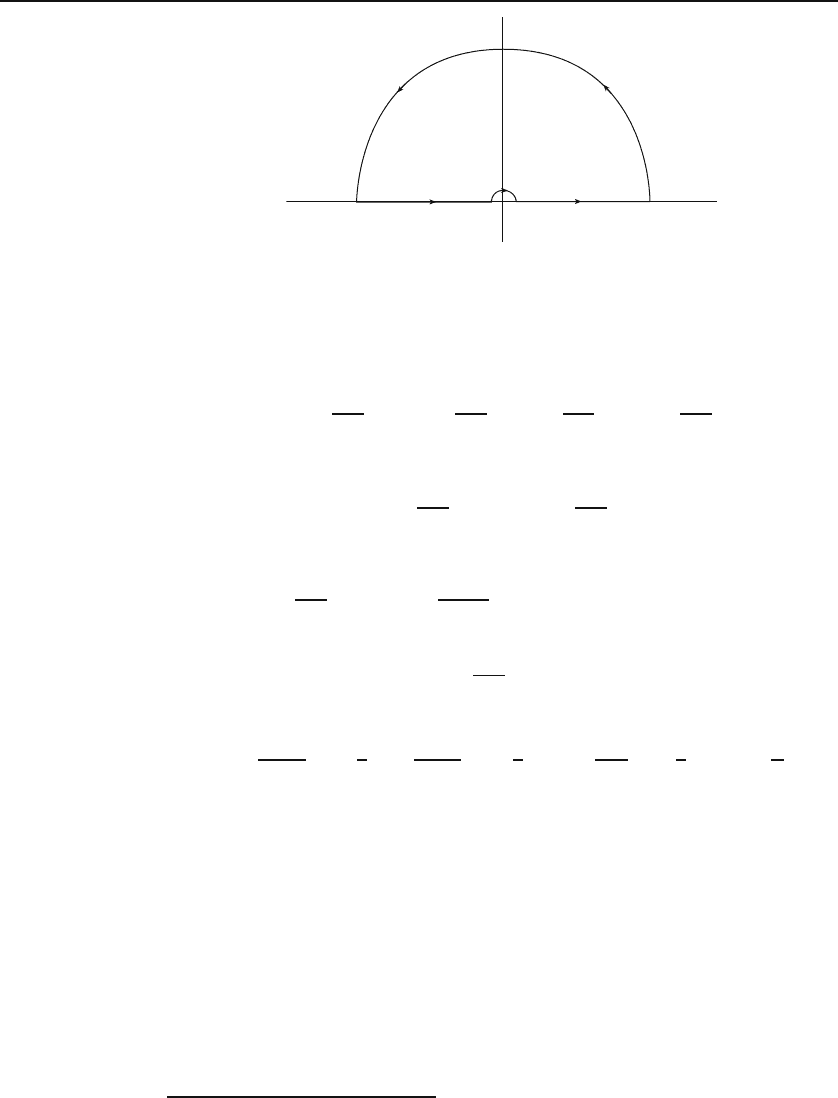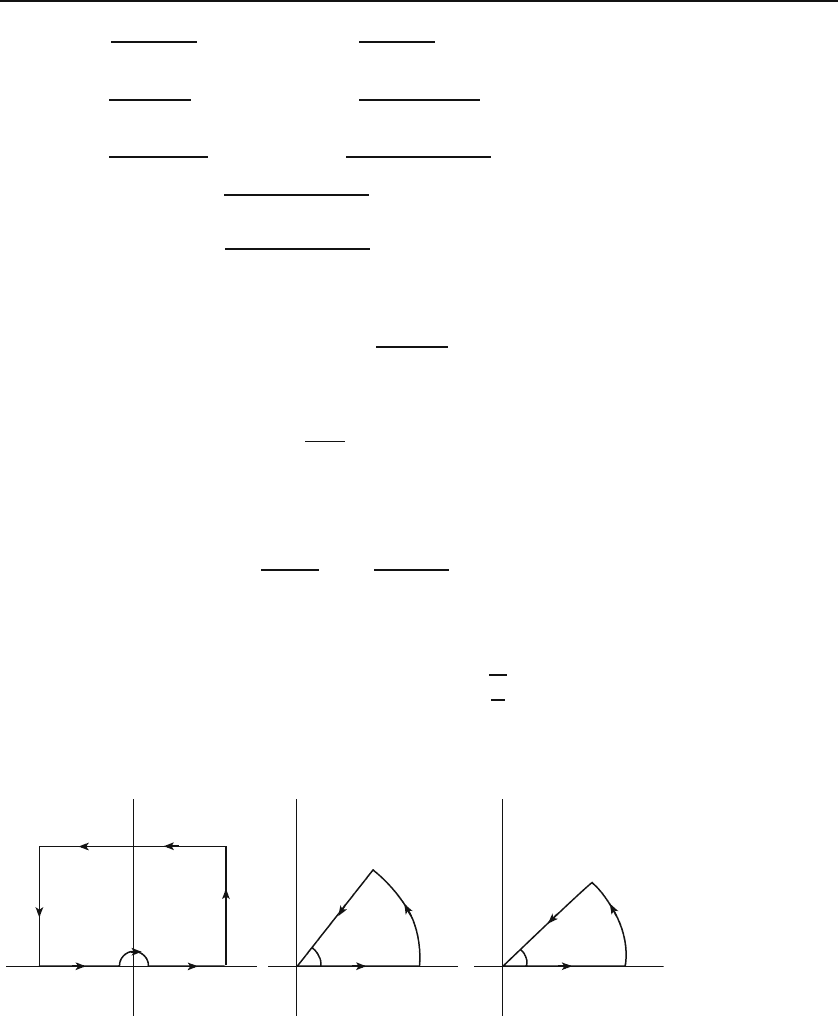Hassani S. Mathematical Methods: For Students of Physics and Related Fields
Подождите немного. Документ загружается.


534 Calculus of Residues
Figure 21.3: To avoid the origin move on an infinitesimal semicircle γ
of radius .
circle of radius as shown in Figure 21.3. This contour does not surround a pole.
Therefore, we can write
0=
2
C
e
iaz
z
dz =
#
−
−∞
e
iax
x
dx +
#
γ
e
iaz
z
dz +
#
∞
e
iax
x
dx
As → 0, the two integrals in x become a single integral over all real numbers.
Thus, we get
#
∞
−∞
e
iax
x
dx = − lim
→0
#
γ
e
iaz
z
dz
But on γ
, z = e
iθ
.Thus
lim
→0
#
γ
e
iaz
z
dz = lim
→0
#
0
π
e
iae
iθ
e
iθ
ie
iθ
dθ = i lim
→0
#
0
π
e
iae
iθ
dθ = −iπ
and
#
∞
−∞
e
iax
x
dx = iπ.
Putting everything together, we obtain
#
∞
0
sin ax
x
dx =
1
2
#
∞
−∞
sin ax
x
dx =
1
2
Im
#
∞
−∞
e
iax
x
dx =
1
2
Im(iπ)=
π
2
If a<0, then sin ax = −sin |a|x and we get the negative of the answer above.
21.4 Functions of Trigonometric Functions
The third type of integral we can evaluate using the residue theorem involves
only trigonometric functions and is typically of the form
#
2π
0
F (sin θ, cos θ) dθ,
where F is some (typically rational) function
3
of its arguments. Since θ varies
from0to2π, we can consider it as the angle of a point z on the unit circle
3
Recall that a rational function is, by definition, the ratio of two polynomials.

21.4 Functions of Trigonometric Functions 535
centered at the origin. Then z = e
iθ
and e
−iθ
=1/z, and we can substitute
cos θ =(z +1/z)/2, sin θ =(z − 1/z)/(2i), and dθ = dz/(iz) in the original
integral to obtain
2
C
F
z − 1/z
2i
,
z +1/z
2
dz
iz
.
This integral can often be evaluated using the method of residues.
Example 21.4.1.
Let us evaluate the integral
2π
0
dθ/(1 + a cos θ)where|a| < 1.
Substituting for cos θ and dθ in terms of z,weobtain
2
C
dz/iz
1+a[(z
2
+1)/2z]
=
2
i
2
C
dz
2z + az
2
+ a
,
where C is the unit circle centered at the origin. The singularities of the integrand
are the zeros of its denominator 2z + az
2
+ a ≡ a(z −z
1
)(z −z
2
)with
z
1
=
−1+
√
1 − a
2
a
and z
2
=
−1 −
√
1 − a
2
a
.
For |a| < 1 it is clear that z
2
will lie outside the unit circle C; therefore, it does not
contribute to the integral. But z
1
lies inside, and we obtain
2
C
dz
2z + az
2
+ a
=2πiRes[f(z
1
)].
The residue of the simple pole at z
1
can be calculated:
Res[f(z
1
)] = lim
z→z
1
(z −z
1
)
1
a(z − z
1
)(z − z
2
)
=
1
a
1
z
1
− z
2
=
1
a
a
2
√
1 − a
2
=
1
2
√
1 − a
2
.
It follows that
#
2π
0
dθ
1+a cos θ
=
2
i
2
C
dz
2z + az
2
+ a
=
2
i
2πi
1
2
√
1 − a
2
=
2π
√
1 − a
2
.
Example 21.4.2. As another example, let us consider the integral
I =
#
π
0
dθ
(a +cosθ)
2
where a>1.
Since cos θ is an even function of θ,wemaywrite
I =
1
2
#
π
−π
dθ
(a +cosθ)
2
where a>1.
This integration is over a complete cycle around the origin, and we can make the
usual substitution:
I =
1
2
2
C
dz/iz
[a +(z
2
+1)/2z]
2
=
2
i
2
C
zdz
(z
2
+2az +1)
2
.
The denominator has the roots z
1
= −a +
√
a
2
− 1andz
2
= −a −
√
a
2
− 1which
are both of order 2. The second root is outside the unit circle because a>1. The
reader may verify that for all a>1, z
1
is inside the unit circle. Since z
1
is a pole of
order 2, we have

536 Calculus of Residues
Res[f(z
1
)] = lim
z→z
1
d
dz
(z − z
1
)
2
z
(z − z
1
)
2
(z −z
2
)
2
= lim
z→z
1
d
dz
z
(z − z
2
)
2
=
1
(z
1
− z
2
)
2
−
2z
1
(z
1
− z
2
)
3
=
a
4(a
2
− 1)
3/2
.
We thus obtain
I =
2
i
2πiRes[f(z
1
)] =
πa
(a
2
− 1)
3/2
.
21.5 Problems
21.1. Evaluate each of the following integrals, for all of which C is the circle
|z| =3:
(a)
2
C
4z − 3
z(z − 2)
dz. (b)
2
C
e
z
z(z − iπ)
dz. (c)
2
C
cos z
z(z − π)
dz.
(d)
2
C
z
2
+1
z(z − 1)
dz. (e)
2
C
cosh z
z
2
+ π
2
dz. (f)
2
C
1 − cos z
z
2
dz.
(g)
2
C
sinh z
z
4
dz. (h)
2
C
z cos
1
z
dz. (i)
2
C
dz
z
3
(z +5)
dz.
(j)
2
C
tan zdz. (k)
2
C
dz
sinh 2z
dz. (l)
2
C
e
z
z
2
dz.
(m)
2
C
dz
z
2
sin z
dz. (n)
2
C
e
z
dz
(z − 1)(z −2)
.
21.2. Find the residue of f(z)=1/ cos z at all its poles.
21.3. Evaluate the integral
∞
0
dx/[(x
2
+1)(x
2
+ 4)] by closing the contour
(a) in the UHP and (b) in the LHP.
21.4. Evaluate the following integrals in which a and b are nonzero real con-
stants:
(a)
#
∞
0
2x
2
+1
x
4
+5x
2
+6
dx. (b)
#
∞
0
dx
6x
4
+5x
2
+1
. (c)
#
∞
0
dx
x
4
+1
.
(d)
#
∞
0
cos xdx
(x
2
+ a
2
)
2
(x
2
+ b
2
)
. (e)
#
∞
0
cos ax
(x
2
+ b
2
)
2
dx. (f)
#
∞
0
dx
(x
2
+1)
2
.
(g)
#
∞
0
dx
(x
2
+1)
2
(x
2
+2)
. (h)
#
∞
0
2x
2
− 1
x
6
+1
dx. (i)
#
∞
0
x
2
dx
(x
2
+ a
2
)
2
.
(j)
#
∞
−∞
xdx
(x
2
+4x + 13)
2
. (k)
#
∞
0
x
3
sin ax
x
6
+1
dx. (l)
#
∞
0
x
2
+1
x
2
+4
dx.
(m)
#
∞
−∞
x cos xdx
x
2
− 2x +10
. (n)
#
∞
−∞
x sin xdx
x
2
− 2x +10
. (o)
#
∞
0
dx
x
2
+1
.
(p)
#
∞
0
x
2
dx
(x
2
+4)
2
(x
2
+ 25)
. (q)
#
∞
0
cos ax
x
2
+ b
2
dx. (r)
#
∞
0
dx
(x
2
+4)
2
.
21.5. Evaluate each of the following integrals by turning them into contour
integrals around the unit circle.

21.5 Problems 537
(a)
#
2π
0
dθ
5+4sinθ
. (b)
#
2π
0
dθ
a +cosθ
where a>1.
(c)
#
2π
0
dθ
1+sin
2
θ
. (d)
#
2π
0
dθ
(a + b cos
2
θ)
2
where a, b > 0.
(e)
#
2π
0
cos
2
3θ
5 − 4cos2θ
dθ. (f)
#
π
0
dφ
1 − 2a cos φ + a
2
where a = ±1.
(g)
#
π
0
cos
2
3φdφ
1 − 2a cos φ + a
2
where a = ±1.
(h)
#
π
0
cos 2φdφ
1 − 2a cos φ + a
2
where a = ±1.
21.6. Use the method of residues to show that
#
π
0
cos
2n
θdθ= π
(2n)!
2
2n
(n!)
2
21.7. Use the contour in Figure 21.4(a) to show that
#
∞
−∞
sin x
x
dx = π
by letting X →∞, Y →∞,and → 0.
21.8. Use the contour in Figure 21.4(b) to show that
#
∞
0
1
1+x
n
dx =
π/n
sin(π/n)
by letting R →∞.
21.9. Use the contour in Figure 21.4(c) to show that
#
∞
0
sin(x
2
) dx =
#
∞
0
cos(x
2
) dx =
π
8
by letting R →∞.
X
−X −ε ε
X
+ iY−X
+ iY
R
R
π
/4
2π /n
R
R
(a) (c)(b)
Figure 21.4: (a) The contour used for sin x/x. (b) The contour used for 1/(1 + x
n
).
(c) The contour used for sin(x
2
).
Part VI
Differential Equations

Chapter 22
From PDEs to ODEs
Physics, as the most exact science, is characterized by its ability to make
mathematical predictions. Predictions are based on two factors: the initial
information (data), and the law governing the physical process. Knowing
what the situation is here and now (initial data, initial conditions, boundary
conditions) enables physics to predict what the situation will be there and
then. This ability to predict is based on the intuitive belief that physical
quantities, dependent on continuous parameters such as position and time,
must be continuous functions of those parameters. Thus, knowledge of the
initial conditions
are needed to
predict the
evolution of a
physical system.
values of those functions at one (initial) point and of how the functions change
from one point to a neighboring point (given by the laws of physics) allows
the values of the functions at the neighboring point to be predicted. Once
the values of the functions are determined at the new point, their values can
be predicted for its neighboring points, and the process can continue until a
distant point is reached.
In mechanics, for example, knowledge of the force acting on a particle of
mass m, located at r
0
and moving with momentum p
0
at time t
0
, allows its
momentum and position at a later time t
0
+Δt to be predicted as follows.
Because dp/dt = F by Newton’s second law of motion, we have
Δp ≈ F(r
0
, p
0
,t
0
)Δt
and
p(t
0
+Δt)=p
0
+Δp ≈ p
0
+ F(r
0
, p
0
,t
0
)Δt.
Similarly,
r(t
0
+Δt) ≈ r
0
+ v
0
t ≈ r
0
+
p
0
m
Δt.
The smaller Δt is, the better the prediction will be.
Newton’s second law of motion,
d
dt
m
dr
dt
= F(r,dr/dt, t)

542 From PDEs to ODEs
is an example of an ordinary differential equation (ODE). A dependentordinary
differential
equation (ODE)
variable r is determined from an equation involving a single independent vari-
able t, the dependent variable r, and its various derivatives.
In (point) particle mechanics there is only one independent variable, lead-
ing to ODEs. In other areas of physics, however, in which extended objects
such as fields are studied, variations with respect to position are also present.
Partial derivatives with respect to coordinate variables show up in the differ-
ential equations, which are therefore called partial differential equations
partial differential
equations (PDEs)
(PDEs). For instance, in electrostatics, where time-independent scalar fields
such as potentials, and vector fields such as electrostatic fields, are studied,
the law is described by Poisson’s equation, ∇
2
Φ(r)=−4πρ(r), where Φ is
the electrostatic potential and ρ is the volume charge density. Other PDEs
occurring in mathematical physics include the heat equation, describing the
transfer of heat, the wave equation, describing the propagation of various
kinds of wave, and the Schr¨odinger equation, describing nonrelativistic quan-
tum mechanical phenomena.
In fact, except for the laws of particle mechanics and electrical circuits,
in which the only independent variable is time, almost all laws of physics are
described by PDEs. We shall not study PDEs in their full generalities, but
concentrate on the simplest ones encountered most frequently in ideal physical
applications. The method of solution that works for all these equations is the
separation of variables,wherebyaPDEisturnedintoanumberofODEs.
Before embarking on the separation of variables, we need to formalize the
discussion above. An ordinary or a partial DE will provide a unique solution
to a physical problem only if the initial or the starting value of the solution
is known. We refer to this as the boundary conditions,orBCsforshort.
the meaning of
boundary
conditions (or
BCs) elaborated
For ODEs, boundary conditions amount to the specification of one or more
properties of the solution at an initial time; that is why for ODEs, one speaks
of initial conditions. BCs for PDEs involve specification of the solution on
a surface (or a curve, if the PDE has only two variables).
22.1 Separation of Variables
We list here the PDEs encountered in undergraduate courses and initiate
their transformation into ODEs. Let us start with the simplest PDE arising
in electrostatic problems, the Poisson equation, derived in Chapter 15,
Poisson equation
Laplace’s equation
∇
2
Φ(r)=−4πρ(r). (22.1)
In vacuum, where ρ(r) = 0, Equation (22.1) reduces to Laplace’s equation,
∇
2
Φ(r)=0. (22.2)
Many electrostatic problems involve conductors held at constant potentials
and situated in a vacuum. In the space between such conducting surfaces, the
electrostatic potential obeys Equation (22.2).

22.1 Separation of Variables 543
Next in complexity is the heat equation, whose most simplified version— heat equation
the one studied here—is
∂T
∂t
= k
2
∇
2
T (r,t), (22.3)
where T is the temperature and k is a real constant characterizing the medium
in which heat is flowing.
Probably one of the most recurring PDEs encountered in mathematical
physicsisthewave equation,
wave equation
∇
2
Ψ −
1
c
2
∂
2
Ψ
∂t
2
=0. (22.4)
This equation (or its simplification to lower dimensions) is applied to the
vibration of strings and drums, the propagation of sound in gases, solids, and
liquids, the propagation of disturbances in plasmas, and the propagation of
electromagnetic waves.
The Schr¨odinger equation, describing the nonrelativistic quantum phe-
Schr¨odinger
equation
nomena, is
−
2
2m
∇
2
Ψ+V (r)Ψ = −i
∂Ψ
∂t
, (22.5)
where m is the mass of a subatomic particle, is Planck’s constant (divided by
2π), V is the potential energy of the particle, and |Ψ(r,t)|
2
is the probability
density of finding the particle at r at time t.
Equations (22.3)–(22.5) have partial derivatives with respect to time. As
a first step toward solving these PDEs, let us separate the time variable. We
will denote the functions in all four equations by the generic symbol Ψ(r,t).
The separation of variables starts with separating the r and t dependence
into factors:
1
Ψ(r,t) ≡ R(r)T (t).
This factorization permits us to separate the two operations of space differ-
time is separated
from space
entiation and time differentiation. As an illustration, we separate the time
and space dependence for the Schr¨odinger equation. The other equations are
done similarly. Substituting for Ψ, we get
−
2
2m
∇
2
(RT )+V (r)(RT )=−i
∂
∂t
(RT ),
or
−T
2
2m
∇
2
R + V (r)(RT)=−iR
dT
dt
,
where we have used ordinary derivatives for T because, by assumption, it is
a function of a single variable. Dividing both sides by RT yields
1
Note that there is no a priori reason why the basic assumption underlying the separation
of variables is legitimate. After all, we cannot write sin(xt) as a product, f(x)g(t). However,
in all cases of physical interest the separation of variables works.

544 From PDEs to ODEs
−
1
R
2
2m
∇
2
R + V (r)=−i
1
T
dT
dt
. (22.6)
Now comes the crucial step in the process of the separation of variables.
central argument
in separation of
variables
The LHS of Equation (22.6) is a function of position alone,andtheRHSisa
function of time alone.Sincer and t are independent variables, the only way
that (22.6) can hold is for both sides to be constant,sayα:
−
1
R
2
2m
∇
2
R + V (r)=α ⇒−
2
2m
∇
2
R + V (r)R = αR
and
−i
1
T
dT
dt
= α ⇒
dT
dt
=
iα
T. (22.7)
We have reduced the original time-dependent Schr¨odinger equation, a
PDE, to an ODE involving only time, and a PDE involving only the posi-
tion variables. Most problems of elementary mathematical physics have the
same property, i.e., they are completely equivalent to Equation (22.7) plus
the equation before it, which we write generically as
∇
2
R + f(r)R =0, (22.8)
where we have simplified the notation by including α in the function f .
The foregoing discussion is summarized in this statement:
Box 22.1.1. The time-dependent PDEs of mathematical physics can be
reduced to an ODE in the time variable and the PDE given in Equation
(22.8). For those PDEs involving second time derivatives, such as the
wave equation, (22.7) will be a second-order ODE.
With the exception of Poisson’s equation, in all the foregoing equations
the term on the RHS is zero. We will restrict ourselves to this so-called
homogeneous case
2
and rewrite (22.8) as
∇
2
Ψ(r)+f(r)Ψ(r)=0. (22.9)
The rest of this section is devoted to the study of this equation in various
coordinate systems.
22.2 Separation in Cartesian Coordinates
In Cartesian coordinates, Equation (22.9) becomes
∂
2
Ψ
∂x
2
+
∂
2
Ψ
∂y
2
+
∂
2
Ψ
∂z
2
+ f (x, y, z)Ψ=0.
2
The most elegant way of solving inhomogeneous PDEs is the method of Green’s func-
tions, of which we shall have a brief discussion in Chapter 29. For a thorough discussion
of Green’s functions, see Hassani, S. Mathematical Physics: A Modern Introduction to Its
Foundations, Springer-Verlag, 1999, Part VI.

22.2 Separation in Cartesian Coordinates 545
As in the case of the separation of the time variable, we assume that we can
separate the dependence on various coordinates and write
Ψ(x, y, z)=X(x)Y (y)Z(z).
Then the above PDE yields
YZ
d
2
X
dx
2
+ XZ
d
2
Y
dy
2
+ XY
d
2
Z
dz
2
+ f (x, y, z)XYZ =0.
Dividing by XYZ gives
1
X
d
2
X
dx
2
+
1
Y
d
2
Y
dy
2
+
1
Z
d
2
Z
dz
2
+ f (x, y, z)=0. (22.10)
This equation is almost separated. The first term is a function of x alone, the
second of y alone, and the third of z alone. However, the last term, in general,
mixes the coordinates. The only way the separation can become complete is
for the last term to be separated as well, that is, expressed as a sum of three
functions, each depending on a single coordinate.
3
In such a special case we
obtain
1
X
d
2
X
dx
2
+
1
Y
d
2
Y
dy
2
+
1
Z
d
2
Z
dz
2
+ f
1
(x)+f
2
(y)+f
3
(z)=0
or
1
X
d
2
X
dx
2
+ f
1
(x)
+
1
Y
d
2
Y
dy
2
+ f
2
(y)
+
1
Z
d
2
Z
dz
2
+ f
3
(z)
=0.
The first term on the LHS depends on x alone, the second on y alone, and
the third on z alone. Since the sum of these three terms is a constant (zero),
independent of all variables, each term must be a constant. Denoting the
constant corresponding to the ith term by −α
i
,weobtain
1
X
d
2
X
dx
2
+ f
1
(x)=−α
1
,
1
Y
d
2
Y
dy
2
+ f
2
(y)=−α
2
,
1
Z
d
2
Z
dz
2
+ f
3
(z)=−α
3
,
which can be reexpressed as
d
2
X
dx
2
+[f
1
(x)+α
1
] X =0,
d
2
Y
dy
2
+[f
2
(y)+α
2
] Y =0,
d
2
Z
dz
2
+[f
3
(z)+α
3
] Z =0,α
1
+ α
2
+ α
3
=0. (22.11)
If f (x, y, z) happens to be a constant C, then the first three terms of Equation
(22.10) can be taken to be respectively −α
1
, −α
2
,and−α
3
, leading to
d
2
X
dx
2
+ α
1
X =0,
d
2
Y
dy
2
+ α
2
Y =0,
d
2
Z
dz
2
+ α
3
Z =0,α
1
+ α
2
+ α
3
= C. (22.12)
3
This is where the limitation of the method of the separation of variables becomes
evident. However, surprisingly, all physical applications, at our level of treatment, involve
functions that are indeed separated.
